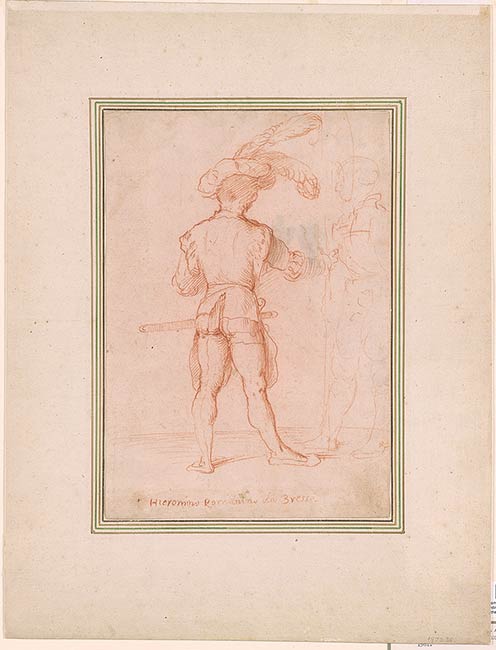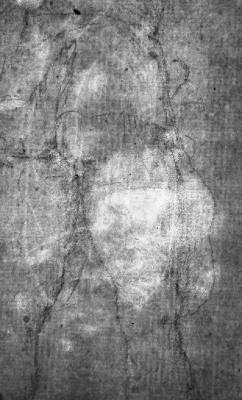
Standing Soldier with a Plumed Hat is one of three exceptional drawings by Romanino in the Morgan’s collection. The other two are the Three-Quarter Length Figure of a Man Leaning Out of an Oculus and the important Musical Group with a Faun,1 also in red chalk, which has been plausibly linked to the fresco decorations of the Castello del Buon Consiglio in Trent. Half a generation older than his compatriot Alessandro Moretto (for whom see I, 72), Romanino too was active throughout northern Italy, particularly in Lombardy and the Veneto. Under the influence of contemporary German artists, especially Albrecht Dürer, Romanino’s art developed expressionistic tendencies apparent in the occasionally exaggerated anatomical proportions and grotesque features of his figures. Besides the Trent cycle, he left important frescoes in the nave of Cremona Cathedral.
Standing Soldier with a Plumed Hat reveals the artist’s confident working method, progressing from a few swiftly drawn, assured outlines for the soldier on the right to the more finished figure at the center, where details such as the dimples in the hat and individual feathers of the plume have been worked up by applying more pressure to the chalk. Crisp, dark red outlines for the doublet, buttocks, thighs, and shin add weight to the sturdy figure, while shading with swift, irregular parallel hatching rounds off the composition.
The heavy sword, the barely discernible halberd, the close-fitting breeches with exaggerated codpiece, the doublet with sleeves slashed to reveal puffs of fabric, the broad, flat hat with tall plumes, and the wide flat shoes of the foreground figure all characterize him as a Landsknecht, a Swiss or German mercenary foot soldier common to war-ravaged Europe in the late fifteenth to the mid-sixteenth century. Exempt from the prevalent sumptuary laws, Landsknechte were conspicuous in their flamboyant dress and must have been an appealing subject for artists. Romanino probably took inspiration for the figure and the way it is set against a low horizon from numerous German prints of mercenary soldiers, beginning with woodcuts by Dürer from around 1500 and including notable examples from the 1520s by Lucas Cranach, Lucas van Leyden, and Sebald Beham, among others, that circulated in northern Italy.
The purpose of Romanino’s drawing is unknown, although it is likely to have been made in preparation for a fresco project involving a military scene or soldiers. Including a figure seen from the back—not unusual for Romanino’s oeuvre—would certainly have added a point of visual interest. A connection with the cycle of the Castello Colleoni in Malpaga, near Bergamo, has been the most plausible suggestion, even though current scholarship attributes only the portico frescoes of ca. 1535 to Romanino while many of the other scenes, including the feats of the condottiere Bartolomeo Colleoni depicted in the salone, are given to Marcello Fogolino.2 The Morgan study has also been associated with the Passion of Christ cycle in the cathedral of Cremona. This is known to date from around 1519, which, however, would seem quite early for the style of the drawing.3
Another drawing by Romanino with a very similar red chalk inscription, reading Hieronimo romani / da bressa, is in the National Gallery of Art, Washington, and depicts the Virgin and Child with SS. Anthony Abbot and Francis and a Donor.4 Although throughout his life Romanino identified himself as being from Brescia, it is not certain that the inscriptions are signatures. They are more likely to have been written by an early collector, possibly already in the sixteenth century.5
—REP
Footnotes:
- Three-Quarter Length Figure of a Man Leaning Out of an Oculus (inv. 1985.94); Musical Group with a Faun (inv. 1973.37).
- Kossoff 1963, 77, first suggested the Malpaga connection. See Nova 1994, no. 69, for Romanino’s Malpaga cycle.
- Michelangelo Muraro in Venice 1957, no. 14, first proposed an association with Cremona Cathedral. See Alessandro Nova’s stylistic arguments for dating the drawing to ca. 1525; Trent 2006, 326.
- National Gallery of Art, Washington, inv. 2006.11.62. See New York 1990, no. 20.
- The similarity of the inscriptions was first noted by Scholz 1958; see also Washington 1995–96, 168.
Inscribed, probably by the artist, at lower center, in red chalk, "Hieronimo Romanino da Bressa".
Watermark: Tall crown with cross (close to Briquet 4899: Bergamo, 1501-1503), seen in transmitted light.
Drey, Franz Alfred, 1886-1953, former owner.
Scholz, János, former owner.
Rhoda Eitel-Porter and and John Marciari, Italian Renaissance Drawings at the Morgan Library & Museum, New York, 2019, no. 75.
Selected references: Oakland and elsewhere 1956, no. 75; Venice 1957, no. 14; Bloomington and elsewhere 1958, no. 30; Scholz 1958, 416; Oakland and San Francisco 1959, no. 59; Ferrari 1961, under no. 30; Cologne 1963-64, no. 136; Kossoff 1963, 77; Peters 1965, 149, 155; London and elsewhere 1968, no. 83; Middletown 1969, no. 16; Pignatti 1970, 82; Washington and New York 1973-74, no. 76; Fellows Report 17 1976, 179; Scholz 1976, no. 50; Cleveland 1981, no. 119; Forlani Tempesti 1990, under no. 28; New York 1990, under no. 20; Trent 2006, no. 61.
Stampfle, Felice, and Jacob Bean. Drawings from New York collections. I: The Italian Renaissance. New York : Metropolitan Museum of Art : Pierpont Morgan Library, 1965, no. 55, pl. 55.
Oberhuber, Konrad, and Dean Walker. Sixteenth Century Italian Drawings From the Collection of János Scholz. Washington, D.C. : National Gallery of Art ; New York : Pierpont Morgan Library, 1973, no. 76, repr. (includes previous bibliography and exhibitions).
Ryskamp, Charles, ed. Seventeenth Report to the Fellows of the Pierpont Morgan Library, 1972-1974. New York : Pierpont Morgan Library, 1976, p. 179.
Scholz, János. Italian Master Drawings, 1350-1800, from the János Scholz Collection. New York : Dover, 1976, no. 50, repr.

